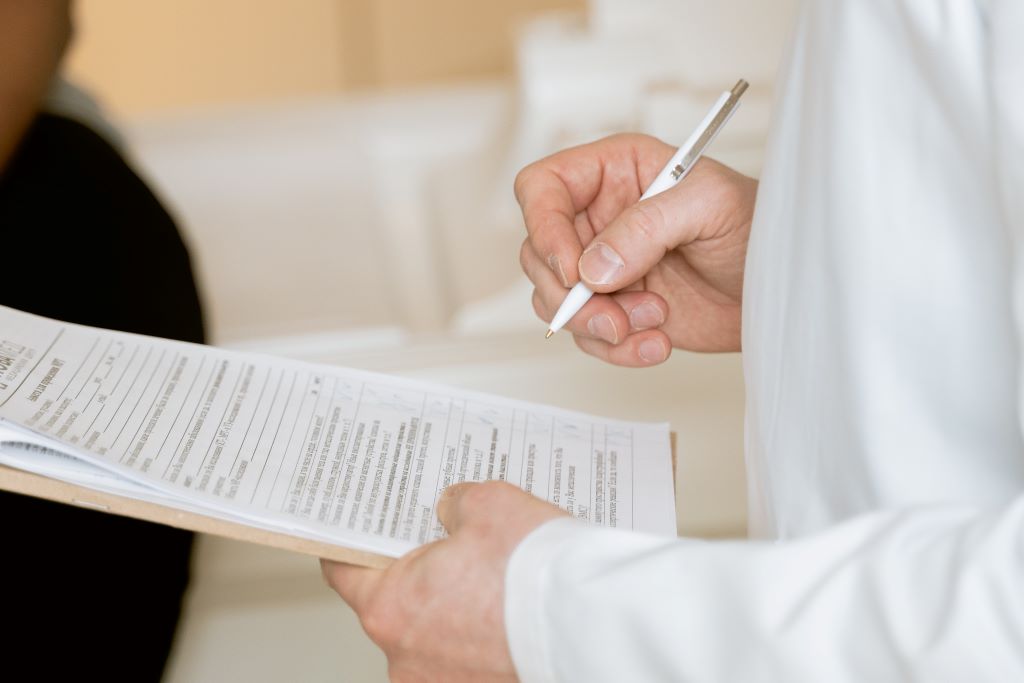Patient assessment and implementation of care requires a systematic history-taking approach, which has to be professional yet able to gain the patient’s confidence and trust. Acquired patient history should include all information relevant to the illness in question, as well as general information about the patient and his or her background, social situation and other problems. Patient assessment should be carried out in a holistic way.
History-Taking Basic Principles
- Ensure that the interview with the patient is taking place in an appropriate, comfortable and private setting
- Introduce yourself and shake hands with the patient
- Address and remember the patient with his or her name
- Treat with respect and courtesy
Basic History-Taking Outline
- presenting complaint history
- medical & surgical history
- drug history
- family history
- social history
- systematic enquiry
1. Presenting Complaint History
- Acquire basic information such as client’s full name, age and address
- Establish the nature and duration of the presenting complaint – when did it start? how? try to acquire the chronological order of main symptom/s onset
- Obtain duration, onset (was it sudden or gradual?), continuation (constant or periodic? frequency? improving or progressing?), precipitating or relieving factors, and associated symptoms eg. feeling lightheaded, out of breath, or sweaty
- If pain is a symptom, determine site, radiation, character (ache? pressure? shooting pain? stabbing pain? dull pain?) and severity (does it stop you from functioning as normal? does the pain wake you up from your sleep?); pain originating from organs is usually dull and compressive, while pain originating from the surface is usually sharp
2. Medical & Surgical History
- Previous illnesses
- Previous admissions to hospital
- Previous surgeries (keep in mind that recent surgery may lead to Pulmonary Embolism)
- Other comorbidities eg. diabetes mellitus, hypertension, hyperlipidaemia, fits, CVAs, heart disease and psychiatric illness
3. Drug History
- Obtain names of all medications that the patient is taking, including over-the-counter drugs, herbal medicines and laxatives
- Determine each drug’s dose, administration frequency, and compliance
- Ask about any known drug allergies or suspected reactions
4. Family History
- Obtain information about any genetic diseases eg. beta thalassaemia
- Obtain information about other diseases eg. hypertension and coronary artery disease which are influenced more with predisposed environmental factors eg. diet and smoking; in the case of heart disease ask about whether the patient’s parents, siblings or children have experienced heart disease
5. Social History
- Ask about the patient’s home environment especially where the patient has mobility or cardio-respiratory problems; determine the number of people living together in the house, the number of rooms, any need for bathroom arrangements, heating (or lack of), steps leading to the house, steps inside the house, and the possibility of the patient sleeping on ground-floor level
- Ask about the patient’s occupation, taking note of any possible exposure to substances related to the patient’s presenting symptoms; unemployment may be a predisposing factor for mental and physical problems; occupation history may provide an insight to the patient’s financial situation
- Ask the patient about personal interests; lack of interests may lead to lack of lifestyle appreciation
- Ask about any habits that may impact the patient’s health eg. alcohol abuse (including quantity of alcohol consumption per day or week – regular consumption of more than 21 units of alcohol per week in males or 14 units in females pose a significant risk of developing alcohol-related disorders such as liver cirrhosis and pancreatitis, as well as hypertension); if patient is a heavy drinker, determine consumption quantity, age of onset of drinking, amount of money spent on alcohol per week, previous drinking habits, related hospital admissions, time of a typical day’s first alochol consumption, and whether drinking happens mostly at home or in a particular place
- Ask about smoking habits, and if present, determine how many cigarettes does the patient smoke daily, as well as age of onset of smoking
- Ask about drug abuse, and if present, what type of drug is being used, mode of administration, any sharing of needles, status of hepatitis and HIV, age of onset of drug use, and reason for using drugs
6. Systematic Enquiry
- Enquire about any other symptoms that may indicate any other unsuspected disease; the following checklist may help…
| Cardiovascular Symptoms |
| – chest pain on exertion |
| – orthopnoea (breathlessness when lying flat) |
| – paroxysmal noctournal dyspnoea (nocturnal breathlessness attacks) |
| – palpitations |
| – ankle swelling |
| – pain in legs upon exertion |
| Respiratory Symptoms |
| – shortness of breath upon exertion |
| – wheezing |
| – coughing |
| – sputum (note colour and amount) |
| – haemoptysis (blood-stained sputum) |
| – chest pain in relation to respiration or coughing |
| Gastroenterological Symptoms |
| – mouth condition (check for tongue infection or bleeding gums) |
| – dysphagia (difficulty swallowing) |
| – indigestion |
| – heartburn |
| – abdominal pain |
| – weight loss |
| – change in bowel habits |
| – stool colour (pale, tarry black, bloody) |
| Urogenital Symptoms |
| – dysuria (pain on passing urine) |
| – urine-passing frequency during the day and night |
| – haematuria (blood in urine) |
| – number of sexual partners |
| CNS-Related Symptoms |
| – headaches |
| – fits |
| – parasthaesia (tingling) |
| – numbness |
| – muscle weakness |
| – hearing problems (eg. deafness, tinnitus) |
| – excessive thirst |
| – sleep patterns |
| Vision-Related Symptoms |
| – appearance of the eyes |
| – vision disturbance |
| – pain |
| Locomotor Symptoms |
| – joint pain or stiffness |
| – muscle pain or weakness |
| Endocrine System Symptoms |
| – heat or cold intolerance |
| – change in sweating |
| – prominence of the eyes |
| – swelling of the neck |
| Male-Related Symptoms |
| -prostatic symptoms (difficulty in starting/passing urine, poor stream, post-micturition dribbling) |
| – erections, ejaculation, frequency of intercourse, urethral discharge |
| Female-Related Symptoms |
| – pre-menopausal (age of onset of periods, regularity, length, blood loss, contraception, and vaginal discharge) |
| – post-menopausal bleeding |
| – stress and urge incontinence |
| – libido and pain during intercourse |
Concluding the History
- ask the patient whether he or she would like to add anything else
- summarise information given and allow the patient to correct you if or where you are wrong
- by analysing the collected information, you may now be able to reach a provisional diagnosis and emphasise on the related physical examination components for patient assessment continuation.
NOTE: when starting a patient assessment, while gathering the patient’s history, it is important to use selective questions to clarify information being relayed, however, do not suggest symptoms or answers to the patient, as that may lead to inaccurate information.
Did you find the above nursing information useful? Follow us on Facebook and fill in your email address below to receive new blogposts in your inbox as soon as they’re published



